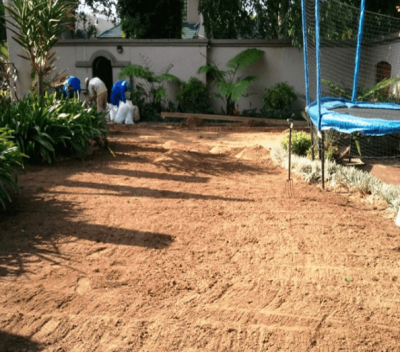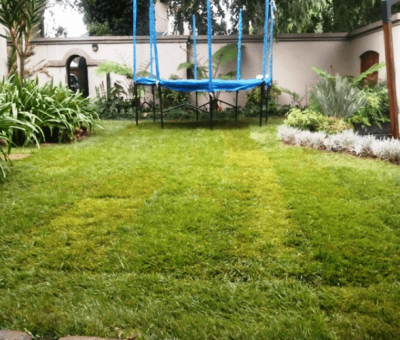
✅ Instant Lawn Options Available in Gauteng
Premium Turf for Homes & Businesses in Gauteng – Johannesburg, Randburg, Midrand, Roodepoort & Sandton
Transform your outdoor space instantly with lush, natural grass.
Subtropical Garden & Pool Services cc supplies, delivers and professionally installs high-quality instant lawn across Gauteng, including Johannesburg, Randburg, Sandton, Roodepoort and Midrand.
Instant lawn is the most affordable green-cover solution – faster and cheaper than planting from seed or using ground-cover plants – giving you a beautiful lawn from day one.
Our warm-season grasses are carefully selected to thrive in the Gauteng climate, offering excellent durability, water efficiency, and year-round appeal.
| Lawn Type | Price from (per m²) | Best For | Key Benefits |
|---|---|---|---|
| Kikuyu Grass | R41/m² | Full sun & high-traffic areas | Fast-growing, hardy, affordable |
| Gulf Green Grass | R48/m² | Residential & commercial lawns | Fine texture, excellent colour |
| Tiffsport Grass | R50/m² | Sports fields & premium lawns | Dense, durable, sports-grade |
| LM Berea Grass | R66/m² | Shade to semi-shade gardens | Soft, shade-tolerant, low maintenance |
| Evergreen Gold Grass | R68/m² | Full sun & semi-shade | Stays green most of the year |
| All Seasons Evergreen | R68/m² | Semi-shade & shade (maintained) | Fine texture, strong colour |
| Big Bag Lawn Seed | R20/m² | Large residential & commercial areas | Cost-effective, fast-establishing |
💡 Prices exclude delivery and installation.
🌿 Ideal Applications
Our instant lawn solutions are perfect for:
-
Residential gardens & estates
-
Office parks & commercial properties
-
Schools, parks & sports facilities
-
Landscaping upgrades & renovations
🌱 Why Choose Subtropical Garden & Pool Services?
✔ Expert advice on lawn selection for sun & shade
✔ Professional soil preparation & turf installation
✔ Fast delivery across Gauteng
✔ Fresh, healthy, weed-free turf
✔ Lawn care guidance & ongoing maintenance options
✔ Competitive pricing & reliable service
✔ Trusted local service since 1995
📦 Optional Add-On Services
-
Topsoil & compost supply
-
Ground levelling & soil preparation
-
Complete garden landscaping
-
Irrigation system design & installation
-
Garden edging installation
-
Seasonal lawn care & fertilisation programmes
📩 Get a Free Instant Lawn Quotation
Ready to enjoy a soft, green, fully established lawn?
📞 Call or WhatsApp Stephan: 083-560-1555
📩 Request a quotation online
🌿 Local, trusted outdoor services since 1995
We provide professional advice, delivery options, and installation pricing for instant lawn in Johannesburg, Randburg, Sandton, Midrand, Roodepoort, and across Gauteng.
👉 Fast response guaranteed – request your free quote today.
🌿 DIY Guide: How to Install Instant Roll-On Lawn
Instant lawn gives you a mature lawn immediately — without waiting months for seed to establish.
✅ STEP 1 — Measure & Order
-
Measure the length and width of your area.
-
Draw a simple sketch, including curves or obstacles.
-
Calculate total square metres (length × width).
📌 Install on the same day as delivery – instant lawn must be laid immediately.
✅ STEP 2 — Prepare the Soil
Dig & Level
-
Dig to a depth of 10–15 cm or add quality topsoil
-
Slope soil slightly away from buildings
-
Remove weeds, stones, roots & debris
-
Lightly compact the soil
Fertilise
-
Apply 2:3:2 or 6:3:4 starter fertiliser
-
Rake lightly into the topsoil
Moisten Soil
-
Lightly water before laying turf (±5 cm deep)
✅ STEP 3 — Lay the Turf
-
Lay immediately on arrival
-
Start from a straight edge (path or driveway)
-
Butt rolls tightly together (no gaps or overlaps)
-
Stagger joints (brick-pattern)
-
Lay across slopes, not down
-
Avoid walking on new turf
-
Lightly roll after installation
-
Water thoroughly once completed
✅ STEP 4 — Watering Schedule
💧 90% of lawn failures are caused by under-watering
General Guideline
| Period | Watering |
|---|---|
| First 2 weeks | Daily (often multiple times in hot weather) |
| Weeks 3–5 | Reduce gradually to once daily |
| After 5 weeks | 2–3 deep waterings per week |
| Established lawn | 1–2 deep waterings weekly (±30 mm) |
🚫 Avoid watering during strong wind
🚫 Do not hand-water
🚫 Common Mistakes
-
Under-watering
-
Hand-watering only
-
Walking on fresh turf
-
Short watering cycles
-
Delayed installation
✅ Best Practice
Install an automated irrigation system with timer for consistent watering and long-term lawn success.
📩 Prefer Professional Installation?
We supply, deliver and install instant lawn across Gauteng:
Johannesburg | Randburg | Sandton | Midrand | Roodepoort
Professional installation ensures:
✔ Correct soil preparation
✔ Proper irrigation
✔ Guaranteed establishment
📞 Call or WhatsApp Stephan on 083-560-1555
📩 Request your free quotation today
💧 Water Restrictions & New Lawn Installation
Please note that municipal water restrictions may apply in different parts of Gauteng. However, exemptions can sometimes be granted for short periods under special circumstances — for example, to allow watering when establishing a new lawn.
Our team can provide guidance on responsible watering practices and assist you with information required for exemption applications where applicable.
📩 Request a free quotation
Interested in our instant lawn supply and installation service?
📞 Get a Free Quotation
📞 Call or WhatsApp Stephan on 083-560-1555
🌿 Local, trusted outdoor services since 1995
Simply complete our Request My Quotation form and we will contact you as soon as possible with pricing, advice and availability.
Let us help you achieve a beautiful, healthy lawn – even in water-wise conditions.


